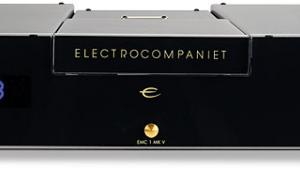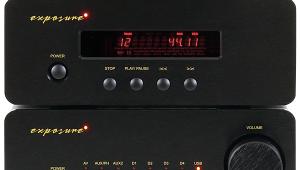Chapter Audio Sonnet S (£6895)
It is no longer sufficient to offer a mere CD player, or even a CD/SACD player when time comes to tempt the well-heeled and digitally-inclined audiophile. Instead, the modern disc spinner must also service a wide range of alternative and necessarily higher resolution digital sources. Machines like the Chapter Audio Sonnet-S featured here are better described as flexible outboard DACs equipped with a mechanism to support the 16-bit granddaddy of all 5in discs. The CD player is dead, long live the CD player. Of course, Chapter is not alone in hedging its digital bets – Cambridge Audio was one of the first to offer a digital input on its CD players with the relatively affordable Azur 840C. Chapter’s Sonnet-S is somewhat less affordable at £6895 but then this unashamedly high-end player does implement a version of the ‘32-bit’ ESS Technology DAC we first saw in Simaudio’s £7950 750D [HFN, July ’10].
HE ’AINT HEAVY
Chapter’s industrial design is clearly hewn from the brute force school of audio engineering, its thick alloy casework loaded down even further by the huge 800VA toroid within [see inside shot, below right]. Similarly, the top-loading transport seems to have been inspired by an industrial centrifuge, complete with huge alloy lid to prevent its contents from spiralling towards the ceiling. Of course, the magnetic disc clamp, visible in our main shot is more than sufficient to keep any CD under control. Under the ‘bonnet’, itself an interference fit with the case, lies the silicon heart of the machine. Here Chapter has deployed a single ‘28-bit’ ES9008 ESS chip, using its modulator and DAC sections but skipping the front-end for a digital filter of its own design. This 4009-tap, three-stage FIR filter is implemented on a Motorola DSP chip and features a cut-off directly at Fs/2 (that’s 22.05kHz for CD). There’s nothing especially fancy about this filter – it’s a fairly conventional brickwall design but set, according to Chapter’s design philosophy, slightly lower than off-the-shelf filters. The upshot is that it sacrifices just a hint of top-end extension to ensure there’s no chance of any aliasing distortions reaching the audioband. Chapter’s digital volume control, accessible by spinning the right hand dial, is also executed in this filter stage and offers a full 132dB range in 0.5dB steps. Situated directly adjacent to this filter and DAC on the PCB is Chapter’s custom master clock. This is based around an avionics crystal but successfully pressed into service outside of the usual oven (thermally controlled) environment.
MENU OPTIONS
While Chapter has endeavoured to keep its fascia as uncluttered as possible, the Sonnet can also be controlled by a Universal Electronics Nevo Q50SL rechargeable learning remote, pre-programmed with Chapter’s IR code. This top quality handset is not included as part of the package but is offered at Nevo’s standard selling price of £600. Personally, I would like to have seen a freebie out-of-the-box remote included with this player. With a bit of practice you can still navigate your way around the Sonnet’s unusual menu using just its two illuminated spin-and-click controls. Unusual? Frankly yes, for I’ve never encountered a player that requires you to pre-select CD de-emphasis before playing such a disc. Granted, there are precious few pre-emphasised CDs on the market but none actually tells you so on the packaging. Ordinarily a pre-emp flag is automatically detected by the CD player and the correction applied in the DAC. This is included in the ESS DAC but in the same DSP stage that Chapter has bypassed, which explains the need for the manual ‘fix’. So if a disc sounds uncommonly bright, try selecting the de-emphasis option. There are other features aimed at its four S/PDIF and single USB digital inputs. You can pre-select the incoming ‘data word length’ (16-bit, 20-bit or 24-bit) for example. This eases the processing overhead, but is unnecessary housekeeping in my view – I’d leave it set to 24-bit at all times. Arguably its most obscure feature is the ‘DAC Modulator Mode’, adjustable between 6 and 8-bits. This represents a trade-off between the S/N achieved in the audioband against the level of unwanted ultrasonic noise. The higher the quantisation ‘width’ the better the audio S/N of the Sonnet-S even if this means more ultrasonic noise being pumped into the partnering amplifier. Teamed with any well-designed amplifier, the 8-bit option should be your default choice. Finally, there’s a ‘Quality’ setting loosely associated with the source of the digital input. The various Low, Medium and High Quality standards address the ESS chip, fine-tuning the selectivity of its phase-locked loop and ability to accommodate variations in the clock accuracy of the incoming data. You may need to set this to Low or Medium for a noisy USB output from a laptop but for all S/PDIF sources, High should be your default.
Of course, while there’s some crossover in technology with the Simaudio 750D, the sound of both products is determined as much by their respective choice and philosophy of analogue engineering. Chapter has its 800VA transformer as part of a low impedance power supply solution that includes a proprietary DC balancing circuit to minimise hum and noise. The balanced Class A analogue output stage features no fewer than 11 very low noise ‘super regulated’ power supplies feeding a selected mix of Burr-Brown, Analog Devices and National Semiconductor op-amps to achieve its ‘house sound’. While I am typically suspicious of any commentator who claims to have ‘warmed to the sound’ of a new product over a week or so (it’s the ears, not the electronics...) I did leave the Sonnet-S powered up for a day before listening, as it takes this long for the warmth of the internals to seep through the mass of its vast alloy casement.
SAMPLING THE SONNET
While the Devialet D-Premier amplifier [HFN, April ’10 and this issue p24] is my preferred choice for digital sources, products offering an analogue output, like the Sonnet-S, are best kept ‘analogue’. So I listened to this player using its own volume control and via balanced TEO cables, through two channels of Krell’s very capable S-1500 amplifier. With the vast majority of source material, CD and external, this control was used within 10-20dB of its maximum to generate realistic peak SPLs from my B&W DM802s, keeping the signal path as short as possible while optimising the available dynamic range of Chapter’s DSP. If your speakers or power amplifier are much more sensitive, and you’re going to be using plenty of genuine 24-bit recordings, then it might be preferable to run the player at full output and insert a preamp inbetween. In my ‘direct’ setup the Sonnet-S was almost perfectly matched for level and delivered a supremely relaxed but dynamically capable performance for my trouble. One of the first CDs to disappear into the Sonnet’s top-loading transport was Philip Clemo’s The Rooms [ACA001], a haunting mix of string quartet with sax, guitar, hammond organ and piano that succeeded in encapsulating the equally broad capabilities of the player itself. This fabulously atmospheric recording oozes an uncanny poise between what might appear, on browsing the sleeve, a disparate collection of acoustic and electronic instruments. And this poise, this clear depiction of macro and micro dynamics, of deep solid bass and sweet but cleanly extended treble is shared by the Sonnet-S. This is my kind of ‘hi-fi’: equipment that offers a tangible sense of performance in the void around the speakers. No strain, no exaggeration and no edgy emphasis to fool the unwary with a short burst of musical fireworks. This player is a stayer, its liquid smooth sound engineered to have you listening long into the wee small hours, night after night. It was during one of these sessions that the Sonnet-S helped me discover Lori Lieberman’s Gun Metal Sky [Drive On Records 115115-09], an equally elegant arrangement of strings, piano, percussion and, of course, her distinctive and eloquent vocals. The Sonnet placed each of these performers into the room with a deft hand, the soft buzz of the trumpet uninterrupted by the greater clarity and impact of piano, recorded more forward in the mix along with the close but not cloyingly intimate quality of her voice. Once again, the Sonnet-S betrayed its innate sense of balance, yielding just enough of the spotlight to illuminate each area of the performance without squeezing another into the shadows.>Just in case the Sonnet was lulling me into a false sense of security I tempted fate by loading a blast from my concert-going past – the live recording of Rainbow’s anthemic ‘Catch The Rainbow’, recently re-released as part of the band’s Anthology 1975-1983. I’d be remiss if I did not pass comment on the necessarily restricted dynamic range, and especially the headroom, available from the master tapes but far from the crushingly disappointing mêlée of Powell’s potent drum sound and Dio’s searing vocals I had experienced with lesser players, here they were all extracted with a surprising sensitivity, along with Blackmore’s legendary fretwork and some tape hiss. Not as good as being there, but a damn close second and little short of miraculous given the quality of the original recording...
FABULOUS FLAC
So what of the modern era of high resolution digital audio? My preferred source on such occasions is the digital output of a Linn Majik DS, connected over a local network to a huge 24-bit NAS archive, the combination governed by a software interface on my laptop. Visitors to our demo at this year’s Bristol Hi-Fi Show will have seen and heard this front-end first hand! Optimally configured, the sound of the Sonnet-as-DAC with a true 96kHz/24-bit recording like Claire Martin’s Too Darn Hot! is quite exceptional – a tight drum sound, incisive piano and brassy percussion plus that breathy vocal presence, all laid onto a canvas of inpenetrable black velvet. The sound is sober but wholly sympathetic to the mood of the performance. Sure enough, I’d would like to have heard a little greater projection into the room, but the soundstage is not squashed, simply deeper than it is forward. It’s worth noting that the extra bit-depth of 44.1kHz/24-bit FLAC versions of Barb Jungr’s Waterloo Sunset offer a tangible advantage over their 44.1kHz/16-bit disc-based cousins, the extra dynamic range realised in deeper, more resonant drum tails, punchier percussion and a little extra expression in those sultry vocals. I would also suggest that the player’s bass extension is subjectively ‘healthier’ in DAC mode, so you should resolve any hint of flabbiness in either amplifier or speaker before attempting a home demonstration of this substantive CD machine.
VERDICT
There are very few high-end CD players being launched these days and those that are do not limit themselves to supporting the 5in disc alone. The smart money, and I include Chapter’s Sonnet-S in this definition, is hedging its bets by offering something closer to a CD-playing outboard DAC. The novelty of a new converter technology also ripens the mix, adding extra appeal and flexibility for the progressive audiophile.
Sound Quality: 80%
Originally published in the October 2010 issue

























































